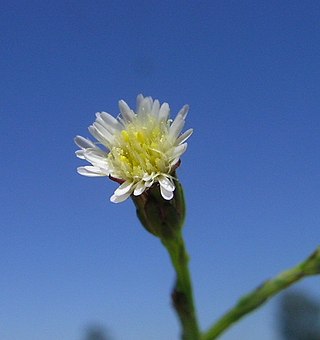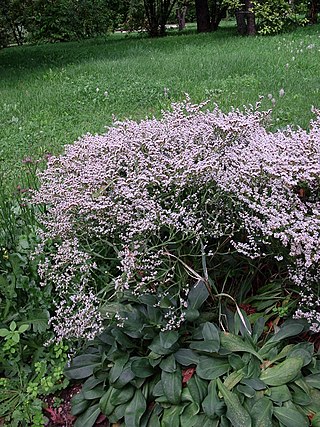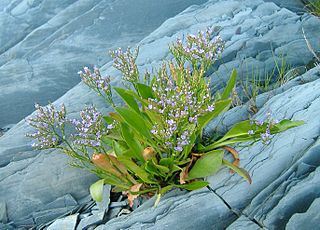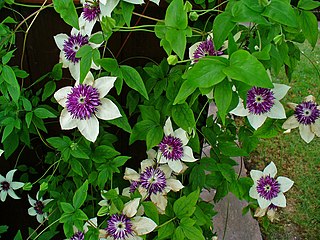
Limonium is a genus of about 600 flowering plant species. Members are also known as sea-lavender, statice, caspia or marsh-rosemary. Despite their common names, species are not related to the lavenders or to rosemary. They are instead in Plumbaginaceae, the plumbago or leadwort family. The generic name is from the Latin līmōnion, used by Pliny for a wild plant and is ultimately derived from the Ancient Greek leimon.

Physocarpus, commonly called ninebark, is a genus of flowering plants in the family Rosaceae, native to North America and northeastern Asia.

Sambucus racemosa is a species of elderberry known by the common names red elderberry and red-berried elder.

Limonium sinuatum, commonly known as wavyleaf sea lavender, statice, sea lavender, notch leaf marsh rosemary, sea pink, is a Mediterranean plant species in the family Plumbaginaceae known for its papery flowers that can be used in dried arrangements.

Limonium perezii is a species of Limonium known by the common names Perez's sea lavender and seafoam statice. It is also known as simply statice, sea lavender or marsh rosemary. It is native to the coasts of the Canary Islands but are widely used in gardens throughout the world.
Limonium solanderi is a species of sea lavender commonly known as native sea lavender. It is native to the Australia, where it is known to inhabit salt marshes and estuaries along the eastern coast from Brisbane to Townsville in Queensland. It has small yellow flowers

Agdistis bennetii is a moth of the family Pterophoridae found in Europe. It inhabits salt marshes.
Iris songarica is a beardless iris in the genus Iris, in the subgenus Limniris and in the series Tenuifoliae of the genus. It is a rhizomatous herbaceous perennial, from Central Asia, located in Afghanistan, Pakistan, Iran, Kazakhstan, Tajikistan, Turkmenistan and Uzbekistan. It has long strap-like leaves, a long stem and 2–3 flowers in shades of violet, dark blue, to lavender blue.

Symphyotrichum subulatum, commonly known as eastern annual saltmarsh aster or, in Britain and Ireland where it is naturalized, annual saltmarsh aster, is an annual plant in the family Asteraceae native to the eastern United States and the Gulf Coast to Texas. The species grows primarily in coastal salt marshes, although in the Ozarks it occurs as a non-marine weedy variety.

Goniolimon, sometimes called the statices, are a genus of flowering plants in the leadwort and plumbago family Plumbaginaceae, native to northern Africa, southern Europe, western and central Asia, Siberia, Mongolia and China. Low-lying perennial shrubs, some species are cultivated as ground covers.

Limonium carolinianum, known variously as Carolina sealavender, canker root, ink root, marsh root, lavender thrift, American thrift, or seaside thrift, is a species of flowering plant native to the eastern shores of North America, from northern Mexico to Canada. It is a slow-growing perennial herb found in salt marshes and other maritime habitats. Its inflorescences are frequently harvested for use in cut flower arrangements.

Clematis florida, the Asian virginsbower, or passion flower clematis, is a species of flowering plant in the family Ranunculaceae. It is native to southern China, and has been introduced to Korea and Japan. A perennial vine, in the wild it is typically found in shrublands and thickets, and alongside streams, at elevations around 1,700 m (5,600 ft). There are a number of cultivars commercially available, including 'Sieboldiana', Pistachio 'Evirida'PBR, and 'Plena'.

Limonium platyphyllum, the broad-leaved statice, or florist's sea lavender, is a species of flowering plant in the family Plumbaginaceae. It is native to the Black Sea region; Bulgaria, Romania, Ukraine, Crimea, south and east European Russia, and the Caucasus, and it has been introduced to Great Britain. A perennial halophyte 60 to 75 cm tall, it is widely available from commercial suppliers. There are a number of cultivars, including the well-known 'Violetta' which has darker petals.

Limonium gmelini, the Siberian statice, is a species of flowering plant in the family Plumbaginaceae, native to east-central and southeastern Europe, Russia, the north Caucasus, Turkey, Iran, Kazakhstan, Kyrgyzstan, parts of Siberia, Xinjiang, and Mongolia. A widespread halophytic species, it is found growing in seeps, meadows, steppes, roadsides, and wastelands, as long as they are saline.

Limonium puberulum, the downy sea lavender, is a species of flowering plant in the family Plumbaginaceae, native to subtropical elevations of Lanzarote in the Canary Islands. It is morphologically similar to but genetically distinct from Limonium bourgeaui.

Limonium bourgeaui is a species of flowering plant in the family Plumbaginaceae, native to Lanzarote and Fuerteventura in the Canary Islands. A herbaceous perennial and subshrub, it is morphologically similar to but genetically distinct from Limonium puberulum.
Limonium sinense is a species of flowering plant in the sea lavender genus Limonium, family Plumbaginaceae, native to coastal China, Taiwan, the Ryukyu Islands, and Vietnam. It is a perennial reaching 60 cm (24 in), found on sandy, salty shales next to the ocean. There are a large number of cultivars, with a wide variety of flower colors, created for the cut flower industry. Wild individuals have flowers with white sepals and yellow petals.

Limonium tetragonum, the square-stalked sea lavender, is a species of flowering plant in the family Plumbaginaceae. It is native to Primorsky Krai in Russia, South Korea, central and southern Japan, the northern Ryukyu Islands, and New Caledonia some 6,800 km (4,200 mi) away. A biennial halophyte, it can be found growing at the high tide line in coastal wetlands and in salt marshes. It is collected in the wild and eaten as a vegetable, and is considered to have medicinal properties. There appears to be an ornamental cultivar, 'Confetti'.

Limonium bonduellei, the yellow statice, is a species of flowering plant in the family Plumbaginaceae. The Global Biodiversity Information Facility calls it Algerian statice and lists it as Limonium sinuatum subsp. bonduellei, but a 2018 molecular study showed that it is good species with 100% bootstrap support. An annual facultative halophyte reaching 50 cm (20 in), it is native to Spain and North Africa, and has been introduced to Italy. It is naturalized in New Zealand.















